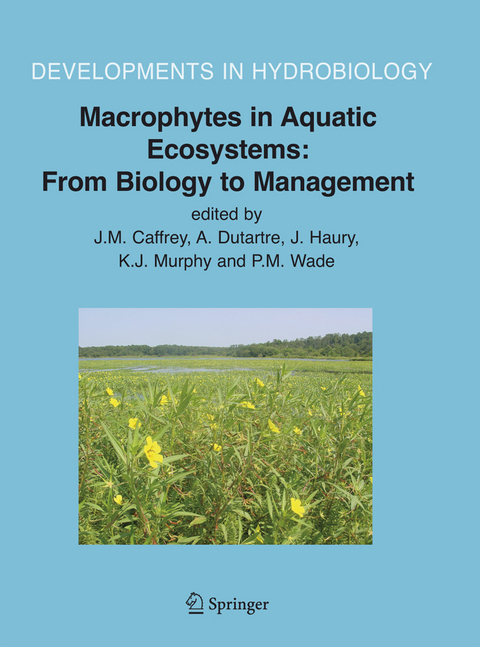
Macrophytes in Aquatic Ecosystems: From Biology to Management
Springer-Verlag New York Inc.
978-1-4020-5389-4 (ISBN)
Macrophytes and macrophytes ecology have gained an added importance with the introduction of, and legal requirement to implement, the European Water Framework Directive. This reflects the valuable role that aquatic plant communities play in assessing the ecological status of water bodies. Significant changes in the status and general abundance of these communities has been recorded in the last three decades, consequent on such factors as global warming and, increasingly, on the spread of aggressive alien species. These changes have been most felt in those waters that are exploited for amenity and recreational pursuits.
The increased biomass of aquatic vegetation in water bodies has adversely impacted on leisure use of these systems but also on their use for agricultural, flood relief, municipal and domestic purposes. The loss to national economies resulting from this excessive plant biomass has been appreciable and has put pressure on water managers to develop weed control procedures that are efficient, environmentally sensitive and cost-effective. The results from the most up-to-date research activities and field trials of leading aquatic plant scientists and managers in all five continents, aimed at resolving these weed problems, has been drawn together in this volume.
The title of this special issue, 'Macrophytes in aquatic ecosystems: from biology to management', is wide-ranging and reflects the broad scope and scale of the papers presented therein. It further recognises the old paradigm: 'knowledge to achieve management and management to achieve knowledge'.
Biology and Species Ecology.- Invasive river plants from Portuguese floodplains: What can species attributes tell us?.- Relationships between macrophytic vegetation and physical features of river habitats: the need for a morphological approach.- Morphological variation in Eichhornia azurea (Kunth) and Eichhornia crassipes (Mart.) Solms in relation to aquatic vegetation type and the environment in the floodplain of the Rio Paraná, Brazil.- Changes in the allocation of some chemical compounds in structures of Oryza glumaepatula (Steud) in an Amazonian lake subjected to an anthropic impact (Lake Batata, Porto Trombetas).- Primary production of Utricularia foliosa L., Egeria densa Planchon and Cabomba furcata Schult & Schult.f from rivers of the coastal plain of the State of São Paulo, Brazil.- An experimental study of the plastic responses of Ranunculus peltatus Schrank to four environmental parameters.- The response of Ceratophyllum demersum L. and Myriophyllum spicatum L. to reduced, ambient, and enhanced ultraviolet-B radiation.- Effect of reservoir drawdown on biomass of three species of aquatic macrophytes in a large sub-tropical reservoir (Itaipu, Brazil).- Populations of Myriophyllum alterniflorum L. as bioindicators of pollution in acidic to neutral rivers in the Limousin region.- Aquatic plant bioassays used in the assessment of water quality in German rivers.- The relationship between Callitriche L. clones and environmental variables using genotyping.- Assessing and predicting the success of Najas flexilis (Willd.) Rostk. & Schmidt, a rare European aquatic macrophyte, in relation to lake environmental conditions.- Community and Bioindication.- Seasonal variability in the palatability of freshwater macrophytes: a case study.- Recovery of Potamogeton pectinatusL. stands in a shallow eutrophic lake under extreme grazing pressure.- Shoreline vegetation of Lake Nubia, Sudan.- Stoneworts (Characeae) and associated macrophyte species as indicators of water quality and human activities in the Pays-de-la-Loire region, France.- Habitat variability of the Littorelletea uniflorae plant communities in Polish Lobelia lakes.- The possibility of submerged macrophyte recovery from a propagule bank in the eutrophic Lake Miko?ajskie (North Poland).- Factors influencing the distribution of aquatic plant communities in Irish canals.- Evaluation of the status of lakes located in the City of Olsztyn (Masurian Lake District, N-E Poland) by the macrophytoindication method (MPhI).- Aquatic plants as environmental indicators of ecological condition in New Zealand lakes.- A new method to assess water trophy and organic pollution — the Macrophyte Biological Index for Rivers (IBMR): its application to different types of river and pollution.- Comparison of different biological indices for the assessment of river quality: application to the upper river Moselle (France).- A comparison of macrophyte indices in headwaters of rivers in Flanders (Belgium).- Solving Problems?.- The prediction of macrophyte species occurrence in Swiss ponds.- Risk assessment method for submerged weeds in New Zealand hydroelectric lakes.- Predicting interactions between wetland vegetation and the soil-water and surface-water environment using diversity, abundance and attribute values.- Richness and structure of plant communities in temporary pools from western Morocco: influence of human activities.- Ecological management of aquatic plants: effects in lowland streams.- Control of Myriophyllum verticillatum L. in Irish canals by turion removal.- The potential for biologicalcontrol of invasive alien aquatic weeds in Europe: a review.- Factors influencing the distribution of Hydrocharis morsus-ranae L. and Rumex hydrolapathum Huds. in a mowed low-lying marshland, Réserve de Cheyres, lac de Neuchâtel, Switzerland.- Evaluating the necessity of additional aquatic plant testing by comparing the sensitivities of different species.- Plasticity of Lythrum salicaria and Phragmites australis growth characteristics across a European geographical gradient.- Use of Geographic Information Systems to monitor and predict non-native aquatic plant dispersal through north-eastern North America.- Present distribution of the genus Elodea in the Alsatian Upper Rhine floodplain (France) with a special focus on the expansion of Elodea nuttallii St. John during recent decades.- Invasibility of four plant communities in the Llobregat delta (Catalonia, NE of Spain) in relation to their historical stability.
| Erscheint lt. Verlag | 5.10.2006 |
|---|---|
| Reihe/Serie | Developments in Hydrobiology ; 190 |
| Zusatzinfo | XII, 264 p. |
| Verlagsort | New York, NY |
| Sprache | englisch |
| Maße | 193 x 260 mm |
| Themenwelt | Naturwissenschaften ► Biologie ► Limnologie / Meeresbiologie |
| Naturwissenschaften ► Biologie ► Ökologie / Naturschutz | |
| Schlagworte | Aquatic Plants • Bio-monitoring • Ecology • Freshwater ecosystems |
| ISBN-10 | 1-4020-5389-4 / 1402053894 |
| ISBN-13 | 978-1-4020-5389-4 / 9781402053894 |
| Zustand | Neuware |
| Haben Sie eine Frage zum Produkt? |
aus dem Bereich


